Cable ferry

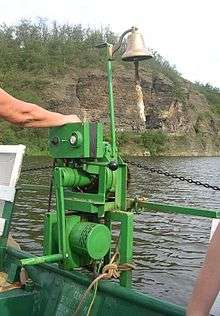
A cable ferry (including the terms chain ferry, swing ferry, floating bridge, or punt) is a ferry that is guided (and in many cases propelled) across a river or large body of water by cables connected to both shores. Early cable ferries often used either rope or steel chains, with the latter resulting in the alternate name of chain ferry. Both of these were largely replaced by wire cable by the late 19th century.
Types
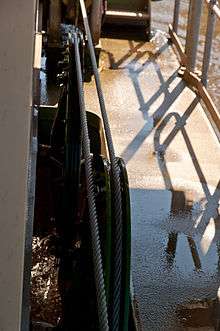
There are three types of cable ferry: the reaction ferry, which uses the power of the river to tack across the current; the powered cable ferry, which uses an engine or electric motors (e.g., the Canby Ferry) to wind itself across; and the fast-disappearing hand-operated type, such as the Stratford-upon-Avon Chain Ferry in the UK and the Saugatuck Chain Ferry in Michigan, USA.
Powered cable ferries use powered cogs or drums on board the vessel to pull itself along by the cables. The cables or chains have a considerable amount of slack built into them, in order to sink below the surface as the ferry moves away, allowing other vessels to pass without becoming grounded, snared or trapped. Where a ferry carries both passengers and vehicles the car deck occupies the centre (helping to balance the vessel) and two passenger areas are at the sides, over the tunnels for the chains and the engines. As the ferry cannot steer a ramp is built at both ends, and there is usually a set of controls facing in either direction.
Cable ferries are common where there is little other water-borne traffic that could get snagged in the cable or chains, where the water may be too shallow for other options, or where the river current is too strong to permit the safe crossing of a ferry not attached to the shore. Alignment of the platform at each end of the journey is automatic and, especially for vehicle ferries, safer than a free-moving ferry might be in bad conditions.
A special type are electrically powered overhead-wire ferries like Straussee Ferry, which have an onboard propulsion unit and can float free, but are connected to the overhead wire for power supply, using an electrical cable that slides along the wire as the ferry moves.
History

Cable ferries have probably been used to cross rivers and similar bodies of water since before recorded history. Examples of ferry routes using this technology date back to the 13th century (Hampton Ferry in England).
In the early 1900s a cable ferry designed by Canadian engineer William Pitt was installed on the Kennebecasis River near Saint John, New Brunswick in Canada.[1] There are now eight cable ferries along the Saint John River system in southern New Brunswick. In Canada a cable ferry is proposed to transport automobiles across the Ottawa River in Ontario. There are several in British Columbia: two on the Fraser, one at Lytton, one at Big Bar, three on Arrow Lakes. A suspended cable ferry worked until the 1980s in Boston Bar. A small seasonal reaction ferry carries cars across the Rivière des Prairies from Laval, Quebec (Sainte-Dorothée neighbourhood) to Île Bizard (part of Montreal).
Cable ferries were particularly prominent in early transportation in the Sacramento Delta of California. Dozens of cable ferries operated on the Columbia River in the US northwest, and most have been rendered obsolete by bridges. A suspended cable ferry for railway cars crossed the American River in Northern California.
Most of the road crossings of the Murray River in South Australia are cable ferries operated by the state government using diesel engines. The platforms at the ends can be moved up or down according to the water level. At one time, cable ferries were a primary means of automobile transportation in New South Wales in Australia. In Tasmania, for a century before 1934, the Risdon Punt at Hobart was the only fixed method of crossing the Derwent River within Hobart city limits.
In the fishing village of Tai O on Lantau Island, Hong Kong, the Tai O Ferry (橫水渡) crossed the Tai O River before a bascule bridge was built.
Ownership
The earliest punts were privately owned by local landowners, and charged a toll. As governments started to build roads, they started to build and operate punts as required. Private punts might be bought out, or made to impose more standard tolls.[2]
Hazards and incidents
- Mannam punt torn by broken cable, and cast adrift.[3]
- Blanchetown punt out of use due to low water level in river.[4]
Duplicated punts can be provided if capacity of one is not enough. Twin ferries allow one to operate while the other is being maintained.[5]
List of cable ferries
Current cable ferries include:
Albania
- Butrint Ferry, across the Vivari Channel near Butrint[6]
Australia



- Berowra Waters Ferry, at Berowra Waters in New South Wales
- Blanchetown Punt[7]
- Cadell Ferry, across the Murray River at Cadell, South Australia[8]
- Daintree River Ferry, across the Daintree River in Queensland
- Hibbard Ferry, across the Hastings River near Port Macquarie, New South Wales[9][10]
- Lawrence Ferry, across the Clarence River in New South Wales[11]
- Lower Portland Ferry, across the Hawkesbury River near the village of Lower Portland, New South Wales
- Lyrup Ferry, across the Murray River at Lyrup, South Australia[8]
- Mannum Ferry, across the Murray River at Mannum, South Australia (two parallel ferries)[8]
- Moggill Ferry, across the Brisbane River near Ipswich, Queensland[12]
- Morgan Ferry, across the Murray River in Morgan, South Australia[8]
- Mortlake Ferry, across the Parramatta River in Sydney, New South Wales
- Narrung Ferry, across the Murray River at Narrung, South Australia[8][13]
- Noosa River Ferry, across the Noosa River in Queensland[14]
- Purnong Ferry, across the Murray River in Purnong, South Australia[8]
- Raymond Island Ferry, from Paynesville to Raymond Island in Victoria
- Sackville Ferry, across the Hawkesbury River near the village of Sackville, New South Wales
- Settlement Point Ferry, across the Hastings River near Port Macquarie, New South Wales[9][10]
- Speewa Ferry, across the Murray River between New South Wales and Victoria at Speewa
- Swan Reach Ferry, across the Murray River in Swan Reach, South Australia[8]
- Tailem Bend Ferry, across the Murray River in Tailem Bend, South Australia[8]
- Ulmarra Ferry, across the Clarence River in New South Wales
- Waikerie Ferry, across the Murray River in Waikerie, South Australia[8]
- Walker Flat Ferry, across the Murray River in Walker Flat, South Australia[8]
- Webbs Creek Ferry, across the Hawkesbury River in the village of Wisemans Ferry, New South Wales
- Wellington Ferry, across the Murray River in Wellington, South Australia[8]
- Wisemans Ferry, across the Hawkesbury River in the village of Wisemans Ferry, New South Wales
- Wymah Ferry, across the Murray River between New South Wales and Victoria
Austria
- Rollfähre Klosterneuburg, across the Danube River at Klosterneuburg
- Drahtseilbrücke Ottensheim, across the Danube River at Ottensheim
Belize
- Xunantunich Ferry, across the Mopan River at Xunantunich
Canada
- Abitibi River Ferry, across the Abitibi River near Cochrane, Ontario
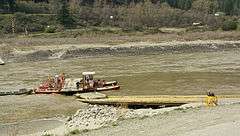
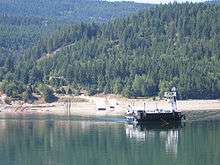
- Adams Lake Cable Ferry, across Adams Lake in British Columbia[15]
- Baynes Sound Connector, saltwater ferry across Baynes Sound in British Columbia. The longest cable ferry in the world as the time of its opening.[16]
- Belleisle Bay Ferry, across Belleisle Bay in New Brunswick
- Big Bar Ferry, across the Fraser River at Big Bar, British Columbia
- Bleriot Ferry, across the Red Deer River near Drumheller, Alberta[17]
- Clarkboro Ferry, across the South Saskatchewan River near Saskatoon, Saskatchewan
- Country Harbour Ferry, across Country Harbour near Port Bickerton, Nova Scotia.
- Crowfoot Ferry, across the Bow River in Alberta[17]
- Englishtown Ferry, across the mouth of St. Anns Bay in Nova Scotia
- Estuary Ferry, across the South Saskatchewan River near Estuary, Saskatchewan
- Evandale Ferry, across the Saint John River in New Brunswick
- Finnegan Ferry, across the Red Deer River in Alberta[17]
- Gagetown Ferry, across the Saint John River in New Brunswick
- Glade Cable Ferry, across the Kootenay River in British Columbia[15]
- Gondola Point Ferry, across the Kennebecasis River in New Brunswick
- Hampstead Ferry, across the Saint John River in New Brunswick
- Harrop Ferry, across the Kootenay River in British Columbia[15]
- Kennebecasis Island Ferry, across the Kennebecasis River in New Brunswick
- Klondyke Ferry, across the Athabasca River in Alberta[17]
- LaHave Cable Ferry, across the LaHave River in Nova Scotia
- Lancer Ferry, across the South Saskatchewan River near Lancer, Saskatchewan
- Laval-sur-le-Lac Île-Bizard Ferry, across the Rivière des Prairies near Montreal, Quebec
- Lemsford Ferry, across the South Saskatchewan River near Lemsford, Saskatchewan
- Little Fort Ferry, across the North Thompson River in British Columbia[15]
- Little Narrows Cable Ferry, across the Little Narrows of Whycocomagh Bay in Nova Scotia
- Low Bar Ferry, across the Fraser River at High Bar, British Columbia
- Lytton Ferry, across the Fraser River at Lytton, British Columbia
- McLure Ferry, across the North Thompson River in British Columbia[15]
- Needles Cable Ferry, across Lower Arrow Lake in British Columbia
- Quyon Ferry, across Ottawa River between Fitzroy Harbour ON & Quyon, QC
- Riverhurst Ferry, across Lake Diefenbaker, Saskatchewan
- Rosevear Ferry, across the McLeod River near Edson, Alberta[17]
- Usk Ferry, across the Skeena River in Usk, British Columbia[15]
- Westfield Ferry, across the Saint John River in New Brunswick
Croatia
- Medsave Ferry, across the Sava River in Zagrebačka županija, overhead cable
 Medsave cable ferry
Medsave cable ferry
Czech Republic
- Dolní Žleb Ferry, reactive ferry across the Elbe at Dolní Žleb near Děčín, lower cable
- Vrané nad Vltavou – Strnady, reactive ferry across the Vltava before Prague, with overhead cable
- Klecánky – Roztoky ferry over the Vltava under Prague, secured by overhead cable
- Máslovice, Dol - Libčice ferry over the Vltava under Prague, secured by lower cable
- Lužec nad Vltavou ferry over the Vltava, secured by overhead cable
- Zlenice - Senohraby swimpool, ferry over the Sázava river, overhead security cable installed but usually unused
- Oseček ferry, Elbe river, formerly secured by overhead cable, now without it
- Kazín ferry, Berounka river, 1992–2007 propulsed through lower chain, since 2015 unsecured boat
- Nadryby ferry, Berounka river, secured by the overhead cable
- Darová ferry, Berounka river, propulsed through the overhead cable
Denmark
- Østre Ferry, across Isefjord between Hammer Bakke and Orø. Uses cables for steering, but propellers for propulsion.
- Udbyhøj Ferry, across Randers Fjord.
Estonia
Finland
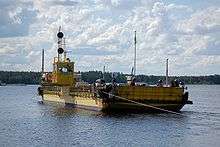
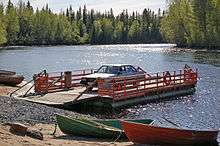

- Alassalmi Ferry, across Alassalmi strait on lake Oulujärvi between Manamansalo island and mainland
- Arvinsalmi Ferry, across Arvinsalmi strait between the municipalities of Rääkkylä and Liperi
- Barösund Ferry, across Barösund strait between Barölandet and Orslandet islands
- Bergö Ferry, in Bergö
- Eskilsö Ferry
- Hanhivirta Ferry, in Enonkoski
- Hirvisalmi Ferry, across Hirvisalmi strait between the mainland and Paalasmaa island in Juuka
- Hämmärönsalmi Ferry, across Hämmärönsalmi strait (Rimito-Hanka) in Rimito, Nådendal (part of r. road 1890)
- Högsar Ferry, between Högsar and Storlandet islands in Nagu, Väståboland (part of r. road 12019)
- Karhun Cable Ferry, between the mainland and the island of Karhu, Ii
- Keistiö Ferry, between Keistiö and Iniö islands in Iniö, Väståboland
- Kivimo Ferry, between Roslax on mainland Houtskär and Kivimo islands in Houtskär, Väståboland
- Kokkila Ferry, between Kokkila on the mainland and Angelniemi on Kemiö island (part of r. road 1835)
- Kyläniemi Ferry, between Utula and Kyläniemi
- Lövö Ferry, between Kasnäs and Lövö islands in Hitis, Kimitoön (part of r. road 1830)
- Mossala Ferry, between Björkö and Mossala islands in Houtskär, Väståboland (part of regional road 12003)
- Pellinki Ferry, between the mainland and the island of Pellinki
- Pettu Ferry, between Pettu and Utö islands in Finby, Salo
- Pikkarala Ferry, across Oulujoki river in Pikkarala, Oulu
- Puutossalmi Ferry, in Kuopio
- Saverkeit Ferry, between mainland Houtskär and Västra Saverkeit islands in Houtskär, Väståboland (part of r. road 12005)
- Skagen Ferry, between Jumo and Iniö islands in Iniö, Väståboland (part of r. road 12230)
- Skåldö Ferry, between Degerö and Skåldö islands in Ekenäs, Raseborg
- Tappuvirta Ferry, Tappuvirrantie
- Vartsala Ferry, between Vartsala and Kivimaa islands in Kustavi (part of r. road 192)
- Vånö Ferry, between Vånö and Attu islands in Pargas, Väståboland (part of r. road 12027)
Åland
- Björkölinjen, across Björkösund strait between the islands of Korsö (in Kumlinge municipality) and Bockholm (in Brändö m.)
- Embarsundlinjen, across Embarsund strait in Föglö municipality, between the islands of Finholma and Jyddö
- Töftölinjen, across Prästösund strait between the islands of Töftö (in Vårdö municipality) and Prästö (in Sund m.)
- Seglingelinjen, across the strait between the islands of Seglinge and Snäckö (both in Seglinge village in Kumlinge municipality)
- Simskälalinjen, across the strait between the islands of Alören and Östra Simskäla (both in Vårdö municipality)
- Ängsösundlinjen, across Ängösund strait between the islands of Lumparland (in Lumparland municipality) and Ängö (in Vårdö m.)
France
- Bac du Sauvage Ferry, across a branch of the Rhône in the Camargue
Germany
.jpg)
- Aken Ferry, across the Elbe at Aken in Saxony-Anhalt
- Barby Ferry, across the Elbe at Barby in Saxony-Anhalt
- Caputh Ferry, across the Havel at Caputh in Brandenburg
- Coswig Ferry, across the Elbe at Coswig in Saxony-Anhalt
- Ferchland Grieben Ferry, across the Elbe between Ferchland and Grieben in Saxony-Anhalt
- Ketzin Cable Ferry, across the Havel at Ketzin in Brandenburg
- Kiewitt Ferry, across the Havel at Potsdam in Brandenburg
- Maintal–Dörnigheim Ferry, across the Main near Maintal in Hesse
- Friesenheimer Insel – Sandhofen Ferry, across an old arm of the Rhine in Mannheim
- Pritzerbe Ferry, across the Havel between Havelsee and Kützkow in Brandenburg
- Rathen Ferry, across the Elbe at Rathen in Saxony
- Räbel Ferry, across the Elbe between Räbel and Havelberg in Saxony-Anhalt
- Rothenburg Ferry, across the Saale at Rothenburg in Saxony-Anhalt
- Sandau Ferry, across the Elbe at Sandau in Saxony-Anhalt
- Straussee Ferry, across the Straussee at Strausberg in Brandenburg
- Teterower See Ferry, to an island in the Teterower See in Mecklenburg-Vorpommern
- Veckerhagen Ferry, across the Weser between Veckerhagen in Hesse and Hemeln in Lower Saxony
- Westerhüsen Ferry, across the Elbe at Magdeburg in Saxony-Anhalt
- Gräpel Cable Ferry, across the Oste at Gräpel in Lower Saxony
Hong Kong

- Nam Sang Wai Ferry, at Nam Sang Wai in northwestern New Territories
Hungary
Italy
- Two cable ferries across the port of Cesenatico, in Romagna
Mozambique
- Ferry across Shire River, 37 km south of Malawi's southernmost border
Netherlands
There are more than 100 cable ferries in the Netherlands,[19] 11 of which use a floating cable with a single anchorage. The larger ones are usually powered by a diesel-powered screw propellor, the smaller ones often use the cable for propulsion. Most of the larger cable ferries angle themselves in the stream to gain part of their propulsion from the current, as a reaction ferry.
Some examples:
- Cuijk ferry, across the Meuse at Cuijk
- Genemuiden ferry, across the Zwarte Water at Genemuiden
- Jonen ferry, across the Walengracht at Jonen, only taking foot passengers and cyclists, winched to the other bank by an electric motor on one of the banks.
- Lexkesveer, across the Nederrijn near Wageningen, first mentioned in 1426
- Oijen Ferry, across the Meuse at Oijen
- Wijhe Ferry, across the IJssel at Wijhe
- Wijk bij Duurstede ferry, across the Lek. This one uses a floating cable.
Norway
- Fjone ferry, across lake Nisser in Nissedal, Telemark[20]
- Espevær Ferry, in Bømlo, Hordaland
- Duesund–Masfjordnes, in Nordhordland
- Mjånes-Hisarøy, in Gulen, Sogn og Fjordane
New Zealand
- Tuapeka Mouth Ferry, in Tuapeka – South Island, on the Clutha River
Poland
_(1).jpg)
- Biechowy Ferry, across the Warta between Biechowy and Piersk[21]
- Borusowa Ferry, across the Vistula between Borusowa and Nowy Korczyn road no. 973[22]
- Brody Ferry, across the Oder at Brody road no. 280[23]
- Brzeg Dolny Ferry, across the Oder between Brzeg Dolny and Głoska
- Ciszyca Ferry, across the Vistula between Tarnobrzeg and Ciszyca road no. 758
- Czchów Ferry, across the Dunajec between Czchów and Piaski Drużków
- Czeszewo Ferry, across the Warta at Czeszewo
- Dębno Ferry, across the Warta between Dębno and Orzechowo
- Gniew Ferry, across the Vistula between Gniew and Janowo road no. 510
- Grzegorzowice Ferry, across the Oder between Grzerorzowice and Ciechowice road no. 421
- Janowiec Ferry, across the Vistula between Kazimierz Dolny and Janowiec
- Korzeniewo Ferry, across the Vistula between Korzeniewo and Opalenie road no. 232
- Kozubów Ferry, across the Warta between Kozubów and Osina
- Krzemienna Ferry, across the San between Krzemienna and Jabłonica Ruska
- Milsko Ferry, across the Oder between Milsko and Przewóz road no. 282
- Nozdrzec Ferry, across the San between Nozdrzec and Dąbrówka Starzeńska
- Opatowiec Ferry, across the Vistula between Opatowiec and Ujście Jezuickie
- Otfinów Ferry, across the Dunajec between Otfinów and Pasieka Otfinowska
- Pogorzelica Ferry, across the Warta between Pogorzelica and Nowa Wieś Podgórna
- Połaniec Ferry, across the Vistula between Połaniec and Gliny Małe
- Połęcko Ferry, across the Oder between Połęcko and Chlebowo road no. 138
- Pomorsko Ferry, across the Oder at Pomorsko road no. 281
- Siedliszowice Ferry, across the Dunajec between Siedliszowice and Wietrzychowice
- Sławsk Ferry, across the Warta between Sławsk and Węglewskie Holendry
- Świniary Ferry, across the Vistula between Baranów Sandomierski and Świniary road no. 872
- Waki Ferry, across the Warta at Waki
Slovakia
- Perec Ferry, across the Perec distributary of the river Hron, between Starý Tekov and Nový Tekov in Levice district - Foot ferry, came into use in the late 18th century and ceased operations in 2014, replaced by a bridge.
South Africa
- Malgas Ferry, across the Breede River at Malgas, Western Cape
South Korea
- Abai village ferry in Sokcho[24]
Spain
Sweden

- Adelsön Ferry, in Lake Mälaren from Munsö to Adelsö[25]
- Ammerö Ferry, in Ravunda Lake from Ammer to Stavre[26]
- Arnö Ferry, in Lake Mälaren from Oknö to Arnö[27]
- Avan Ferry, across Lule River from Avan to Norra Sunderbyn[28]
- Boheden Ferry, across Djupträsket from Sandudden to Boheden[29]
- Bohus Malmön Ferry, from Malmön to Roparöbacken[30]
- Bojarkilen Ferry, across Bojarkilen in Strömstad[31]
- Bolmsö Ferry, across Lake Bolmen from Sunnaryd to Bolmsö[32]
- Hamburgsund Ferry, across Hamburgsund from Hamburgsund to Hamburgön[33]
- Högmarsö Ferry, from Högmarsö to Svartnö[34]
- Högsäter Ferry, across Byälven from Högsäter to Fryxnäs[35]
- Isö Ferry, across Storsjön from Isön to Norderön[36]
- Ivö Ferry, across Ivö Lake between Barum and Ivö Island[37]
- Kostersundet Ferry, across Kostersundet from Nordkoster to Sydkoster[38]
- Torpön Ferry, across Lake Sommen from Torpön to Blåvik[39]
- Ytterö Ferry, from Ytterön to Yttre park[40]
Switzerland
United Kingdom
- Butts Ferry, across the River Exe in Exeter, Devon
- Cowes Floating Bridge, across the River Medina on the Isle of Wight
- Dartmouth Higher Ferry, across the River Dart in Devon
- Hampton Ferry, across the River Avon near Evesham in Worcestershire
- Hampton Loade Ferry, across the River Severn in Shropshire
- King Harry Ferry, across the River Fal in Cornwall
- Reedham Ferry, across the River Yare in Norfolk
- Sandbanks Ferry, across the entrance to Poole Harbour in Dorset
- Stratford-upon-Avon Ferry, across the River Avon at Stratford-upon-Avon in Warwickshire
- Torpoint Ferry, across the River Tamar between Devon and Cornwall
- Trowlock Island Ferry, to Trowlock Island in the River Thames
- Windermere Ferry, across Windermere in Cumbria
United States
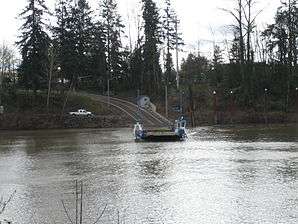
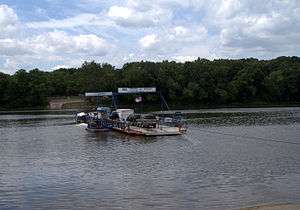


- Akers Ferry, across the Current River near Salem in Missouri
- Avoca Island Ferry, across the intracoastal waterway to Avoca Island near Morgan City in Louisiana
- Bemus-Point Stow Ferry, across Chautauqua Lake in New York
- Buena Vista Ferry, across the Willamette River in Oregon
- Canby Ferry, across the Willamette River in Oregon
- Los Ebanos Ferry, across the Rio Grande between Los Ebanos, Texas and Gustavo Díaz Ordaz, Tamaulipas
- Elwell Ferry, across the Cape Fear River in North Carolina
- Fredericktown Ferry, across the Monongahela River in southwestern Pennsylvania[41]
- Hatton Ferry, across the James River in Virginia
- Ironton Ferry, across an arm of Lake Charlevoix in Michigan
- J-Mack Ferry, across an arm of the Sacramento River in California[42][43]
- Merrimac Ferry, across the Wisconsin River in Wisconsin
- Merry Point Ferry, across the Corrotoman River in Virginia
- Parker's Ferry, across the Meherrin River in North Carolina
- Princeton Ferry, across the Sacramento River in California[43]
- Sans Souci Ferry, across the Cashie River in North Carolina
- Saugatuck Ferry, across the Kalamazoo River in Michigan
- Sunnybank Ferry, across the Little Wicomico River in Virginia
- Sycamore Island Ferry, across the Potomac River in Maryland
- Ticonderoga Ferry, across Lake Champlain between Ticonderoga, New York and Shoreham, Vermont
- Upper Ferry, across the Wicomico River in Maryland[44]
- Valley View Ferry, across the Kentucky River in Kentucky
- Wheatland Ferry, across the Willamette River in Oregon
- White's Ferry, across the Potomac River in Maryland
- Whitehaven Ferry, across the Wicomico River at Whitehaven, Maryland[44]
- Woodland Ferry, across the Nanticoke River in Delaware[44]
Zambia
- Chambeshi Ferry, across the Chambeshi River near Mbesuma
- Kabompo Ferry, across the Kabompo River 80 km south-east of Kabompo
- Kafue Ferry, across the Kafue River 4.5 km west of the Zambezi
Zimbabwe
- Ekusileni Ferry, across the Insiza River downstream of Filabusi
See also
References
- ↑ "Saint John, New Brunswick First". Retrieved November 20, 2006.
- ↑ "ORIGINAL CORRESPONDENCE.". The Argus. Melbourne: National Library of Australia. 7 April 1856. p. 5. Retrieved 7 June 2012.
- ↑ "PUNT ADRIFT.". The Register. Adelaide: National Library of Australia. 19 November 1913. p. 13. Retrieved 4 June 2012.
- ↑ "PUNT WORKING.". The Advertiser. Adelaide: National Library of Australia. 5 March 1953. p. 11. Retrieved 4 June 2012.
- ↑ "Blanchetown Punt.". The Advertiser. Adelaide: National Library of Australia. 13 April 1953. p. 4. Retrieved 4 June 2012.
- ↑ de:Vivar-Kanal
- ↑ "Blanchetown Punt.". The Advertiser. Adelaide: National Library of Australia. 25 November 1954. p. 4. Retrieved 4 June 2012.
- 1 2 3 4 5 6 7 8 9 10 11 "Ferry Locations and Operational Status". Government of South Australia. Retrieved 2008-11-27.
- 1 2 "Council rejects call to change ferry service management". ABC. Retrieved 2008-12-24.
- 1 2 "New Settlement Point Ferry". Port Macquarie – Hastings Council. Retrieved 2008-12-24.
- ↑ "Speewa Ferry – Murray River". New South Wales Roads and Traffic Authority. Retrieved 2008-11-18.
- ↑ Dickinson, Alex; Earley, David (2008-09-25). "Moggill Ferry master saves man after Brisbane River mishap". Courier Mail. Retrieved 2008-12-09.
- ↑ "Walkabout – Meningie". Fairfax Digital. Retrieved 2008-11-27.
- ↑ "Noosa North Shore Car Ferries". Noosa North Shore Car Ferries. Retrieved 2008-11-11.
- 1 2 3 4 5 6 "Inland Ferry Schedules". Province of British Columbia. Retrieved 2008-11-25.
- ↑ "New Cable Ferry for Buckley Bay-Denman Island Service". BC Ferries.
- 1 2 3 4 5 "Government of Alberta Transportation Ferries". Government of Alberta. Retrieved 2009-07-03.
- ↑ "Köteles komp Soroksár és Csepel között (csepeli-soroksári komp) - Wikimapia". wikimapia.org. Retrieved 2016-06-02.
- ↑ "List of ferry types in the Netherlands" (in Dutch). Vrienden van de voetveren. Retrieved 2014-03-09.
- ↑ https://dittdistrikt.no/aktiviteter/472394/fjoneferja – Fjone cable ferry, in Norwegian with English summary
- ↑ "Prom rzeczny (52.215265,18.434951)" [River ferry (52.215265,18.434951)]. Google Maps. Google. Retrieved 2012-01-29.
- ↑ "Prom rzeczny (50.290066,20.801754)" [River ferry (50.290066,20.801754)]. Google Maps. Google. Retrieved 2012-01-29.
- ↑ "Prom rzeczny (52.055176,15.42901)" [River ferry (52.055176,15.42901)]. Google Maps. Google. Retrieved 2012-01-29.
- ↑ "Healing Retreat in Sokcho". Visit Korea.
- ↑ "File:Adelson farja 2008.JPG". Wikimedia Commons. Retrieved 2009-01-19.
- ↑ "Ammeröleden". Trafikverket.
- ↑ "Arnöleden". Trafikverket.
- ↑ "Avanleden". Trafikverket.
- ↑ "Bohedenleden". Trafikverket.
- ↑ "Bohus Malmönleden". Trafikverket.
- ↑ http://www.stromstad.se/omkommunen/forvaltningar/tekniska/hamnar/linfarjor/linfarjabojarkilen.500.html
- ↑ "Bolmsöleden". Trafikverket.
- ↑ "Hamburgsundsleden". Trafikverket.
- ↑ carita holmberg. "Högmarsö Färja".
- ↑ "Högsäterleden". Trafikverket.
- ↑ "Isöleden". Trafikverket.
- ↑ "File:Linfärjan Karna, Ivösjön.jpg". Wikimedia Commons. Retrieved 2009-01-19.
- ↑ "Trädfällning inom tätort".
- ↑ "Camping, Boende & Hyra stuga i Östergötland av Torpöns Färjeläge".
- ↑ "Hem".
- ↑ Hamill, Sean D. (2009-05-17). "Getting There From Here, Is It Better by the Ferry?". The New York Times. Retrieved 2010-04-28.
- ↑ "The Cable Guy – Piloting the Delta's J-Mack ferry beats working for a living". Prosper Media, LLC. Retrieved 2008-12-01.
- 1 2 "Ferries". California Delta Chambers and Visitor's Bureau. Retrieved 2008-12-01.
- 1 2 3 Shellenberger, William H (2001). Cruising the Chesapeake. McGraw-Hill Professional. pp. 236–237. ISBN 0-07-136371-8.
